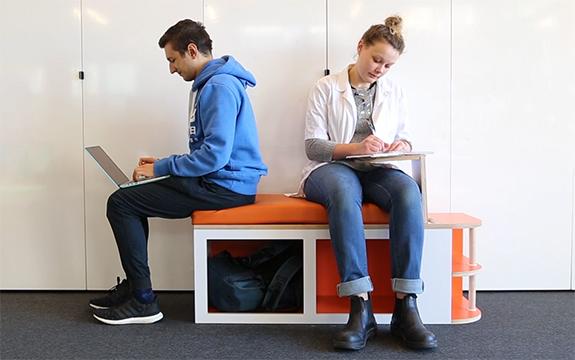

Published on the 13th September 2019 by ANSTO Staff
A Challenged Based Innovation platform at nandin, ANSTO’s Innovation Centre, is progressing as part of a funding package from the NSW Government and a Memorandum of Understanding with Swinburne University of Technology and Design Factory Melbourne (DFM).
The first collaborative activity since the agreement was a project for two DFM students to re-design the cabin space for new synchrotron beamlines as part of Project Bright.

Illustration of exterior view of beamline user cabin design, CODED, by Jing Tan
They completed a design solution for the special purpose instrument cabins that are used to prepare instrument samples, run an experiment, and analyse data.
Melanie Phillips and Jing Tan created a proof-of-concept solution and design prototype that improved on the existing design in use.
Synchrotron scientists and engineers were involved in the design process, which also included observation and prototype testing.
“The key challenge was to propose design solutions that were user-centric, fit for purpose and would accommodate different functions and stakeholder needs,” said Tiina Tuulos, Innovation Coach, DFM.
The design concept, CODED, improved workflow in the cabin. The design separated working areas into colour-coded areas. Different colours were used for sample, science and user areas. Dedicated areas were designated for personal belongings to reduce clutter and improve access.

Melanie Phillips (right) of DFM/Swinburne University sits on newly designed modular unit for instrument cabin
Curved structural glazing created a feeling of spaciousness to give scientists and engineers a sense of connection with the external world.
Observers can see into the cabin without entering. Ambient lighting was used throughout, including the floor to reduce trip hazards.
The designers created improved storage and writing surfaces. The selection of height-adjustable furniture improved ergonomics and reduced fatigue. A computer monitor was more easily cleaned by embedding it.
Prof Andrew Peele, Director of the Australian Synchrotron, said the approach was both practical and highly creative and would provide a greatly improved space for future users of the new instruments.
Read more about Challenge Based Innvation at nandin
Read more about the cabin redisgn